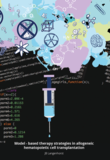Model-based therapy in allogeneic hematopoietic cell transplantation

Langenhorst, Jurgen
- Promoter:
- Prof.dr. A.D.R. (Alwin) Huitema
- Co-promoter:
- Dr. J.J. (Jaap Jan) Boelens & dr. C. (Charlotte) van Kesteren
- Research group:
- Nierkens
- Date:
- May 14, 2019
- Time:
- 14:30 h
Summary
Allogeneic hematopoietic cell transplantation is a potentially curative treatment for a variety of malignant and benign disorders. However, the treatment comes with significant risks, resulting in chance of death due to the treatment, depending on indication, of 10-40%. The full treatment consists of: (1) donor selection, (2) breaking down the patients’ immune system, and (3) the transplant. Thereafter a new system will recover (4).
Throughout this thesis, mathematical models are used to improve the different aspects this high-risk treatment. The donor preferably comes from a sibling, with an immune system genetically identical to that of the patient. Such a donor is however often not available, necessitating the search for alternative donor sources. In this thesis, it is shown that cord blood is an excellent alternative, with comparable outcome to sibling donors and less long-term complications. Also, immune recovery is faster compared to the other alternative donor sources.
Breaking down the patients’ immune system is often done using a combination of high-dose chemotherapy, often consisting of busulfan with fludarabine. Busulfan dosing is already tailored to the individual, but for fludarabine the optimal dose is unknown. In this thesis it is shown that precise dosing of fludarabine can lead to highly increased chance of survival by making the treatment itself safer. In addition, methods were developed to achieve such precise dosing.
The various studied described in this thesis contribute to a higher chance of survival after allogeneic cell transplantation.